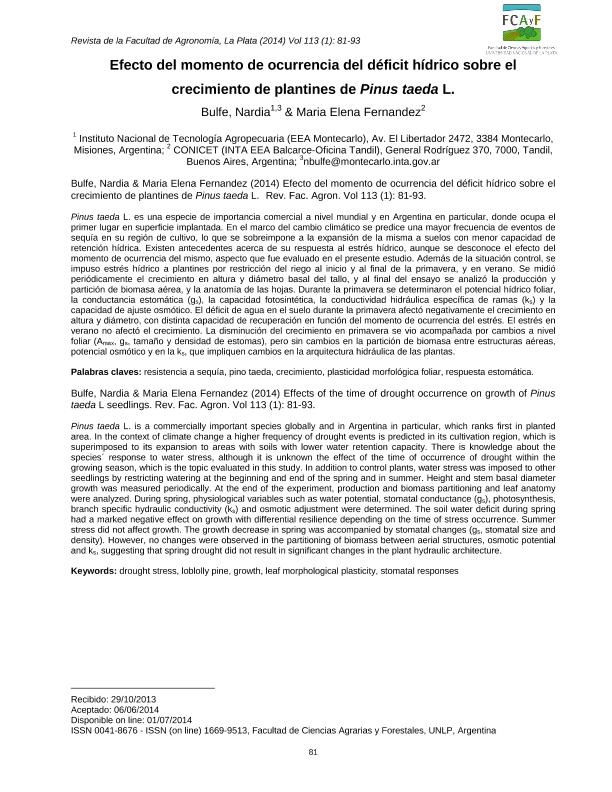Mostrar el registro sencillo del ítem
dc.contributor.author
Bulfe, Nardia M. L.

dc.contributor.author
Fernandez, Maria Elena

dc.date.available
2018-01-29T14:34:55Z
dc.date.issued
2014-07
dc.identifier.citation
Bulfe, Nardia M. L.; Fernandez, Maria Elena; Efecto del momento de ocurrencia del déficit hídrico sobre el crecimiento de plantines de Pinus taeda l.; Universidad Nacional de La Plata. Facultad de Ciencias Agropecuarias y Forestales; Revista de la Facultad de Agronomía; 113; 1; 7-2014; 81-93
dc.identifier.issn
0041-8676
dc.identifier.uri
http://hdl.handle.net/11336/34838
dc.description.abstract
Pinus taeda L. es una especie de importancia comercial a nivel mundial y en Argentina en particular, donde ocupa el primer lugar en superficie implantada. En el marco del cambio climático se predice una mayor frecuencia de eventos de sequía en su región de cultivo, lo que se sobreimpone a la expansión de la misma a suelos con menor capacidad de retención hídrica. Existen antecedentes acerca de su respuesta al estrés hídrico, aunque se desconoce el efecto del momento de ocurrencia del mismo, aspecto que fue evaluado en el presente estudio. Además de la situación control, se impuso estrés hídrico a plantines por restricción del riego al inicio y al final de la primavera, y en verano. Se midió periódicamente el crecimiento en altura y diámetro basal del tallo, y al final del ensayo se analizó la producción y partición de biomasa aérea, y la anatomía de las hojas. Durante la primavera se determinaron el potencial hídrico foliar, la conductancia estomática (gs), la capacidad fotosintética, la conductividad hidráulica específica de ramas (ks) y la capacidad de ajuste osmótico. El déficit de agua en el suelo durante la primavera afectó negativamente el crecimiento en altura y diámetro, con distinta capacidad de recuperación en función del momento de ocurrencia del estrés. El estrés en verano no afectó el crecimiento. La disminución del crecimiento en primavera se vio acompañada por cambios a nivel foliar (Amax, gs, tamaño y densidad de estomas), pero sin cambios en la partición de biomasa entre estructuras aéreas,potencial osmótico y en la ks, que impliquen cambios en la arquitectura hidráulica de las plantas.
dc.description.abstract
Pinus taeda L. is a commercially important species globally and in Argentina in particular, which ranks first in planted area. In the context of climate change a higher frequency of drought events is predicted in its cultivation region, which is superimposed to its expansion to areas with soils with lower water retention capacity. There is knowledge about the species ́ response to water stress, although it is unknown the effect of the time of occurrence of drought within the growing season, which is the topic evaluated in this study. In addition to control plants, water stress was imposed to other seedlings by restricting watering at the beginning and end of the spring and in summer. Height and stem basal diameter growth was measured periodically. At the end of the experiment, production and biomass partitioning and leaf anatomy were analyzed. During spring, physiological variables such as water potential, stomatal conductance (gs), photosynthesis, branch specific hydraulic conductivity (ks) and osmotic adjustment were determined. The soil water deficit during spring had a marked negative effect on growth with differential resilience depending on the time of stress occurrence. Summer stress did not affect growth. The growth decrease in spring was accompanied by stomatal changes (gs, stomatal size and density). However, no changes were observed in the partitioning of biomass between aerial structures, osmotic potential and ks, suggesting that spring drought did not result in significant changes in the plant hydraulic architecture.
dc.format
application/pdf
dc.language.iso
spa
dc.publisher
Universidad Nacional de La Plata. Facultad de Ciencias Agropecuarias y Forestales
dc.rights
info:eu-repo/semantics/openAccess
dc.rights.uri
https://creativecommons.org/licenses/by-nc-sa/2.5/ar/
dc.subject
Resistencia a Sequía
dc.subject
Pino Taeda
dc.subject
Crecimiento
dc.subject
Plasticidad Morfológica Foliar
dc.subject
Respuesta Estomática
dc.subject.classification
Agricultura

dc.subject.classification
Agricultura, Silvicultura y Pesca

dc.subject.classification
CIENCIAS AGRÍCOLAS

dc.title
Efecto del momento de ocurrencia del déficit hídrico sobre el crecimiento de plantines de Pinus taeda l.
dc.title
Effects of the time of drought occurrence on growth of Pinus taeda L seedlings
dc.type
info:eu-repo/semantics/article
dc.type
info:ar-repo/semantics/artículo
dc.type
info:eu-repo/semantics/publishedVersion
dc.date.updated
2018-01-26T18:56:15Z
dc.journal.volume
113
dc.journal.number
1
dc.journal.pagination
81-93
dc.journal.pais
Argentina

dc.journal.ciudad
La Plata
dc.description.fil
Fil: Bulfe, Nardia M. L.. Instituto Nacional de Tecnología Agropecuaria; Argentina
dc.description.fil
Fil: Fernandez, Maria Elena. Instituto Nacional de Tecnología Agropecuaria; Argentina. Consejo Nacional de Investigaciones Científicas y Técnicas; Argentina
dc.journal.title
Revista de la Facultad de Agronomía
dc.relation.alternativeid
info:eu-repo/semantics/altIdentifier/url/http://revista.agro.unlp.edu.ar/index.php/revagro/article/view/30/
Archivos asociados
